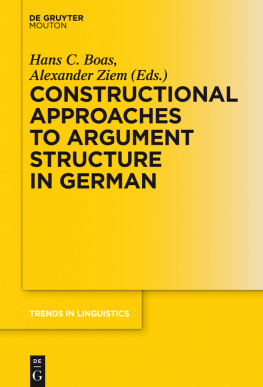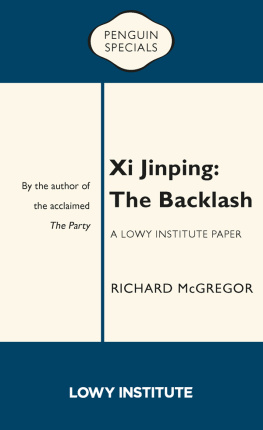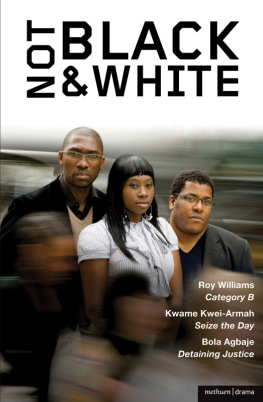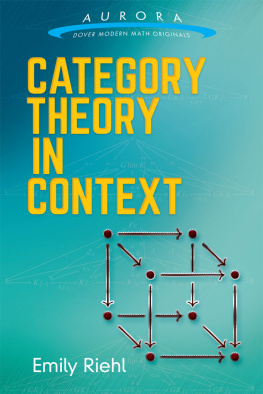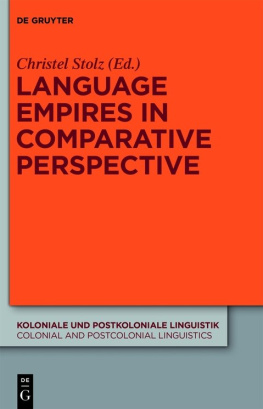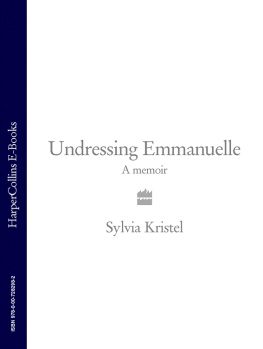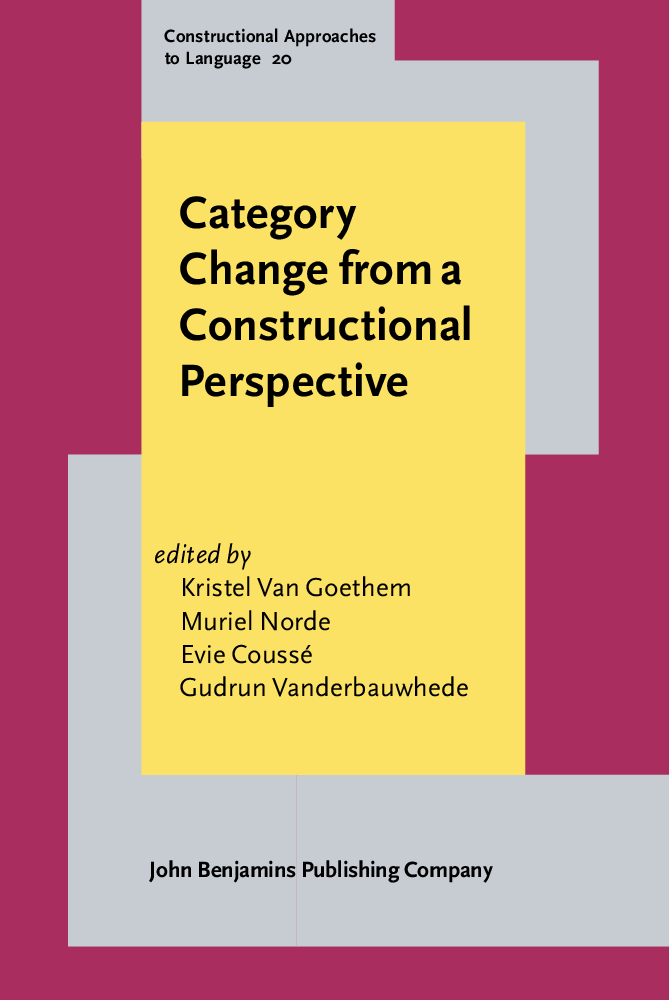

Category Change from a Constructional Perspective
Kristel Van Goethem Muriel Norde Evie Couss Gudrun Vanderbauwhede
doi: 10.1075/cal.20
ISBN: 978 90 272 6435 0 (ebook)
Cataloging-in-Publication Data available from Library of Congress:
LCCN 2017055770
2018 John Benjamins B.V.
No part of this book may be reproduced in any form, by print, photoprint, microfilm, or any other means, without written permission from the publisher.
John Benjamins Publishing Company https://benjamins.com
John Benjamins Publishing Company
Amsterdam/Philadelphia
Acknowledgements
This collection of papers grew out of a two-day workshop on category change from a constructional perspective, organised by Muriel Norde and Kristel Van Goethem at the 8th International Conference on Construction Grammar at the University of Osnabrck, on September 45, 2014. We would like to thank the contributors to this workshop as well as the people in the audience for stimulating discussion. Since the workshop was such a success, we decided to publish a selection of the papers, and we would like to express our sincere gratitude to a number of colleagues and friends who have assisted us along the way. First of all, we are greatly indebted to two anonymous reviewers of the volume as a whole, as well as to the reviewers of the individual papers for very helpful comments and suggestions for improvement: Dany Amiot, Lot Brems, Bert Cornillie, Bernard De Clerck, Timothy Colleman, Renata Enghels, Teresa Fanego, Livio Gaeta, Jack Hoeksema, Lotte Hoogeweg, Matthias Hning, Claudio Iacobini, Eva Skafte Jensen, Bob de Jonge, Kristin Killie, Barbara Schlcker, Tim Thornes, Elizabeth Traugott, Turo Vartiainen, Freek Van de Velde, An Van linden, and Dominique Willems. Thanks are also due to Iliyana Braykova, Seda Gerehan and Sarah Sippach at Humboldt-Universitt zu Berlin for their meticulous work on the references. Finally, we are grateful to Jan-Ola stman of the CAL series for his invaluable feedback and encouragement, and to Esther Roth and Susan Hendriks for guiding us through the editorial process.
Louvain-la-Neuve / Berlin / Gteborg / Mons, December 2017
Kristel Van Goethem
Muriel Norde
Evie Couss
Gudrun Vanderbauwhede
Part I Introduction
Chapter 1 Category change from a constructional perspective Introduction Kristel Van Goethem, Muriel Norde, Evie Couss & Gudrun Vanderbauwhede
F.R.S.-FNRS & Universit catholique de Louvain | Humboldt-Universitt zu Berlin | University of Gothenburg | Universit de Mons
Linguistic categories : Discrete or gradient?
The classification of the lexicon into categories (in the sense of word classes or parts of speech) has been a fundamental matter of concern in linguistics since ancient times and still forms the center of interest in recent publications (e.g. , p.46), this ultimately implies that syntactic categories are derivative of in fact epiphenomenal to the representation of grammatical knowledge. On this view, categories can be defined in two ways: either construction-specifically, as the class of fillers of a particular role in a single construction, or cross-constructionally, as the class of fillers that has an identical distribution across the relevant roles for all constructions in a language, or at least some specified set of constructions in the language (ibidem). In other words, a construction-specific category is the class of words that can occur in the empty slot in a specific constructional schema such as the definite NP construction [the __]NP (e.g. box, woman, rich, poor but not *perfectly, *your). A cross-constructional category is a group of words that typically occur in the same constructions, e.g. count nouns occur in the definite NP construction just given, but also in the plural construction, the binominal compound construction, and so on.
Alternatively, studies building on the Neogrammarians view (e.g., ).
Category change
Category change, broadly defined as the shift from one word class to another, is inherent to different processes of change, yet a comprehensive typology of these processes and their defining features is missing to date (see also )) and ablaut (e.g. spreek V to speak vs spraak N speech in Dutch), the most important category-change processes include the following:
derivational affixation, e.g. happy A > happi-ness N
conversion: Dutch gek A crazy > gek N fool
transposition: French Elle est dun courageux lit. She is of a brave; She is very brave, cf. )
reanalysis: the key Nto success > a key N/Apoint > Customer satisfaction is very key Ato us, cf. ).
Whereas derivation by affixation and conversion are morphological and context-independent processes, transposition is by definition dependent on a specific syntactic context. However, the boundary between the processes is not absolute, as suggested by cases such as Elle est dun calme! lit. She is of a calm; She is very calm (, p.18), such as the reanalysis of English to be going to from main verb to future auxiliary (I am going to the train station vs I am going to be a star).
The different types of category shift mentioned above can be arranged on a continuum, from abrupt to gradual and from context-independent to context-sensitive. While the A > N conversion of for instance Dutch gek crazy; fool is abrupt and context-independent, N > A shifts are often the result of a gradual process, starting out in a specific syntactic environment (the bridging context, cf. ).
Another distinguishing criterion between the different category-change processes is directionality. Whereas in earlier work (e.g. ).
Category change has been mostly studied as part of other changes. In theorizing about grammaticalization and lexicalization, which featured prominently on the linguistic agenda in the 1990s and the 2000s, category change was generally considered an inherent part of grammaticalization or lexicalization changes which by definition involve shifts in the status of lexical or grammatical morphemes (cf. ) has recently gained a lot of interest and should be interpreted in this context.
This volume
The central aim of this volume is to rethink the notions of category and category change from a diachronic Construction Grammar perspective, in order to explore whether category change can be explained more accurately by analysing it as an instance of constructionalization (, p.36). More specifically, the papers in this volume address one or more of the following research questions:
Are categories grammatical primitives, or are they defined by the constructions they occur in (cf. , pp.4647)?
What is the status of category change in a diachronic construction grammar framework (e.g. ) and how can the different types outlined above be accounted for?
How can the notions of gradualness and context-sensitivity be modelled in a constructional framework? Does the gradualness of some category shifts imply that categories synchronically form a continuous spectrum (, p.242)?
Is category change a change in form which together with a change in meaning constitutes constructionalization and if so, is it the shift itself or changes in morphosyntactic properties (e.g. decategorialization) that are associated with it?






